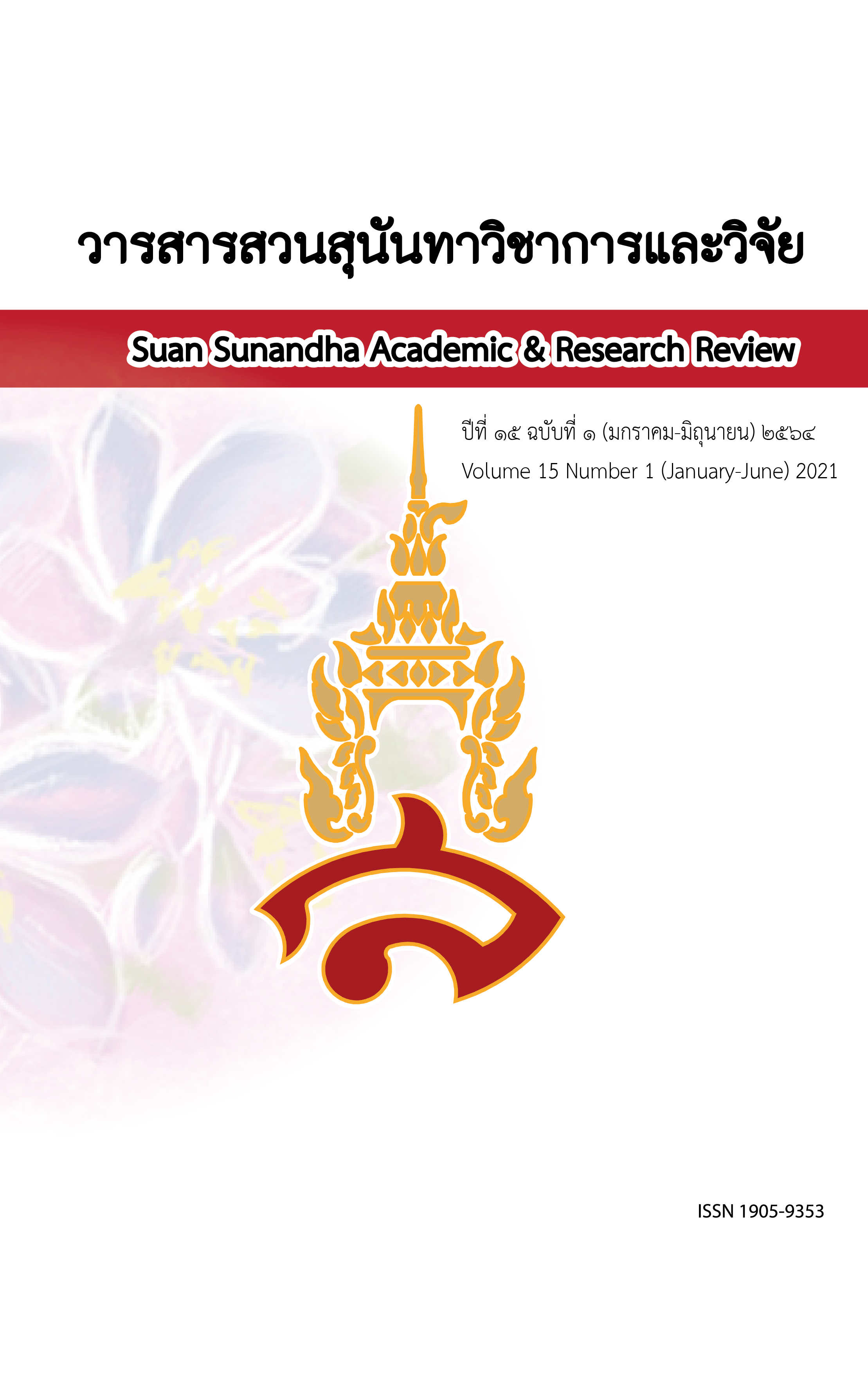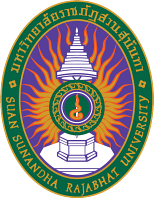ความเชื่อ รูปเคารพ และบทบาทศาลเจ้าพ่อพระปรง ชุมชนบ้านหนองผูกเต่า อำเภอเมืองสระแก้ว จังหวัดสระแก้ว
คำสำคัญ:
ศาลเจ้าพ่อพระปรง, ความเชื่อ, บทบาท, จังหวัดสระแก้วบทคัดย่อ
การวิจัยนี้ศึกษาการก่อตั้งและพัฒนาการของศาลเจ้าพ่อพระปรง ความเชื่อต่อรูปเคารพ และบทบาทของเจ้าพ่อพระปรงต่อชุมชน โดยใช้วิธีการวิจัยเชิงคุณภาพเก็บข้อมูลโดยการสังเกต การบันทึกภาพ การสัมภาษณ์เชิงลึก และคำบอกเล่าจากผู้ให้ข้อมูลหลัก จำนวน 9 คน ประกอบด้วย ผู้มีส่วนเกี่ยวข้องในการก่อตั้งและพัฒนาการ ประชาชนที่มาสักการะบูชา และชาวบ้านที่มีส่วนเกี่ยวข้อง วิเคราะห์และสังเคราะห์ด้วยวิธีการพรรณนาผลการศึกษา พบว่า ศาลเจ้าพ่อพระปรงเดิมไม่ปรากฏว่าผู้ใดก่อตั้ง พบครั้งแรกเป็นเพียงเศษไม้เล็ก ๆ ลักษณะคล้ายศาลตั้งอยู่บนพื้นดินใต้ต้นไม้ใหญ่ริมแม่น้ำแควพระปรง หมู่ที่ 9 ตำบล บ้านแก้ง อำเภอสระแก้ว จังหวัดปราจีนบุรี ชาวบ้านที่ทำไร่ทำนาอยู่บริเวณนั้นได้กราบไหว้อธิษฐานขอพรเพื่อให้พืชผลของตนที่เพาะปลูกมีความอุดมสมบูรณ์ เมื่อสมความปรารถนาจึงนำหัวหมูและเหล้าขาว “สุราไทย” มาเป็นเครื่องเซ่นสังเวยสักการะบูชา ต่อมาในคราวสร้างศาลาการเปรียญวัดวิหารธรรม “บ้านหนองผูกเต่า” ขาดแคลนทุนทรัพย์ซื้อสังกะสีมุงหลังคา ชาวบ้านจึงมีความคิดร่วมกันในการจัดประเพณีและหาทุนทรัพย์มาพัฒนาวัด ดังนั้น นายสมัย จันทวงษ์ ผู้นำชุมชนจึงได้นำชาวบ้านตั้งปะรำพิธีขึ้นที่บริเวณหน้าบ้านของตน ณ สี่แยกถนนสุวรรณศรหมายเลข 33 “หลักกิโลเมตรที่ 227 สายเก่า” และในบ่ายวันที่ 12 เมษายน พ.ศ. 2507 ได้เชิญองค์รูปเจ้าพ่อพระปรงมาทำพิธีสักการะบูชาและเจริญพระพุทธมนต์ เพื่อให้ชาวบ้านและผู้สัญจรผ่านไปมาได้สักการะบูชาขอพรและสรงน้ำในช่วงเทศกาลสงกรานต์เพื่อเป็นสิริมงคลชีวิตและครอบครัว ระหว่างวันที่ 13-15 เมษายน พ.ศ. 2507 เป็นเวลา 3 วัน 3 คืน จนเป็นประเพณีสืบมา และในปี พ.ศ. 2517 มีการเปิดใช้เส้นทางถนนสุวรรณศรสายใหม่ ได้มีการตั้งศาลเจ้าพ่อพระปรงขึ้นอีกแห่งที่บริเวณริมฝั่งแม่น้ำแควพระปรง ณ ถนนสุวรรณศร หลักกิโลเมตรที่ 226 เขตรอยต่อระหว่างจังหวัดปราจีนบุรี-สระแก้ว และพัฒนาเป็นประเพณีวันไหลจังหวัดสระแก้วในเทศกาลสงกรานต์จนถึงปัจจุบัน โดยมีความเชื่อต่อรูปเคารพเจ้าพ่อพระปรง 3 ประการ ได้แก่ ปกป้องคุ้มภัยภยันตรายในชีวิตและครอบครัว เดินทางแคล้วคลาดปลอดภัยไม่ให้ประสบอุบัติเหตุ และประกอบอาชีพการงานประสบความสำเร็จสมปรารถนา ขณะเดียวกันมีบทบาทต่อชุมชน 4 ประการ ได้แก่ ศูนย์รวมและที่พึ่งทางจิตใจของชาวบ้านและผู้ศรัทธา แหล่งการเรียนรู้สืบทอดมรดกภูมิปัญญาทางวัฒนธรรมนำคำว่า “ด่าน...” มาเป็นคำนำหน้านามสกุลครอบครัว คุณค่าของภูมิปัญญามรดกทางวัฒนธรรม และเพิ่มมูลค่าเศรษฐกิจครัวเรือนส่งเสริมการท่องเที่ยวจังหวัดสระแก้ว
เอกสารอ้างอิง
Anan Kanjanaphan. (2012). ChaoThi and Phi Pooya: The dynamics of villager knowledge, power, and identity of local people. Chiang Mai: Chiang Mai University.
Boonyong Ketthet. (2014). Ghost way of the people: Beliefs and dependence between people and ghosts. Mahasarakham: Kakaia.
Chanont Chaithongdee. (2019). The community spirits and its roles on constructing sacred space in Sisaket Province. Mekong-Salween Civilization Studies Journal, 10(2), 219-255.
Dictionary of Royal Institute. (2020). Belief. Retrieved November 15, 2020, from https://dict.longdo.com/search/%E0%B8%84.
Dictionary of the Royal Institute. (2021). Court. Retrieved January 20, 2021, from https://dictionary.orst.go.th/
Gaoyun. L. (2014), Na Jasa Tai Chee shrine: Fidelity, character and role (Master’s thesis). Thai Studies, Faculty of Humanities and Social Sciences, Burapha University. Chonburi.
Got questions. (2020). Modern idolatry. Retrieved November 2, 2020, from https://www.gotquestions.org/Thai/Thai-modern-idolatry.html.
Katematu Duangmanee. (2015). Similarities and differences of vegetarian-festival rituals at Chinese Shrines in Trang Province. Journal of Yala Rajabhat University, 10(2), 107-122.
Komol Chantawong. (2018). Participation of Chao Pho Phra Prong shrine in Nong Phuk Tao community. Faculty of Humanities and social Sciences, Valaya Alongkorn Rajabhat University under the Royal Patronage. Phetchaburi.
Komol Chantawong. (2018). The enhancement of education leaders in integrating learning process between school and community (Doctoral dissertation). Faculty of Education, Burapha University. Chonburi.
Kunchai Apisuphap. (2004). A Study of Beliefs Concerning Chinese Shrines in The Municipality of Songkhla. (Master's thesis). Thai Khadi Studies, Graduate School, Thaksin University. Songkhla.
Nakhon Nayok Provincial Tourism Office. (2020). Chao Phra Prong Sacred things in Sa Kaeo Province. Retrieved January 20, 2020, from https://www.facebook.com/tatnayokfans/posts/670893012924987/.
Narupon Duangwises. (2017). Anthropological Concepts and the Studies of Animistic Beliefs in Thai Society. Academic Journal of Humanities and Social Sciences Burapha University, 25(47), 173-197.
Nisa Chuto. (1997). Qualitative research. Bangkok: P.N. Printing.
Nix Bunnasan. (2018). Chao Pho Phra Prong shrine, attractions reviews. Retrieved January 20, 2021, from http://www.wongnai.com/attractions/375282ge-ศาลเจ้าพ่อพระปรง
Nukul Thammachong. (2013). Religious belief system of Karen or Karang. Journal of Pathumthani University, 8(1), 8-13.
Prapaneethaidotcom. (2020). The tradition of sprinkle water onto Phra Prong, Sa Kaeo Province. Retrieved January 20, 2021, from http://www.prapayneethai.com/1.
Punyawat Watharagan. (2012). Divine things and Thai society. Retrieved January 15, 2021, from http://punyawat63.blogspot.com/2012/12/blogpost.html?_trms=abb32711ae4795f7.1622080743879
Sa Kaeo Provincial Cultural Office. (2018). Biography of Chao pho Phra Prong, Sa Kaeo Province Folklore, Tales, Stories, Muang Sakaeo. Retrieved January 20, 2020, from https://www.facebook.com/117142525008650/posts/1122421774480715
SaeLim. S. and Wongkitrungruang. C. (2017). Existence, Adaptation and Adaptation of the Kuan Impud Jor at Ban Khuan Ngaeng, Bang Dee, Huai Yot Trang Province. Social Development Branch Kasetsart. University Journal of Yala Rajabhat University. Year 12 (2) Jul - Dec 2017
Sanid Naksuksri. (2013). Opening remarks at the releasing ceremony of the Phra Prong God Goddess in the Lai Day Festival of the Godfather Phra Prong Province, Sa Kaeo Province [Open speech document]. Sa Kaeo: Sa Kaeo Provincial Cultural Office.
Sanook.com. (2021). Thai myths and beliefs. Retrieved January 15, 2021, from http://www.tumsrivichai.com.
Sirirat Adsagun. (2010). Family institution: Development and change. Bangkok: Chulalongkorn University Press.
Srisak Wallipodom and Walailuk Songsiri. (2008). Nakorn Prae from the past to the present: Geography, culture, belief systems and local history (Research report). Bangkok: Thailand Science Research and Innovation.
Srisak Wallipodom. (1999). Holy power and public power in local society. Retrieved on January 15, 2021, from https://lek-prapai.org/home/view.php?id=908.
Supang Chanthawanich. (2009). A qualitative research method. Bangkok: Chulalongkorn University Press.
Supaporn Saelim and Chairat Wongkitrungruang. (2017). The existence, adaptation and transmission of Guan Im Pud Jor Chinese shrine in Khuan Nga Chang, Bangdee Sub-district, Huai Yot District, Trang Province. Journal of Yala Rajabhat University, 12(2), 15-30.
Thawat Boonyamanee. (2007). Leadership and change. Bangkok: Odeon Store.
Wikipedia. (2020). Idols. Retrieved November 20, 2020, From http://th.wikipedia.org/wiki/ไอดอล.
Yurachat Chartsuthichai. (2011). Story of the court…the belief that the dependence of the Thai people. ManagerOnline. Retrieved May 20, 2020, from https://mgronline.com/columnist/detail/9540000112880
Yuzra, K. (2015). Holy thing is…what? Retrieved November 2, 2020, from https://www.islammore.com/main/content.php?page=sub&category=15&id=2276.
ดาวน์โหลด
เผยแพร่แล้ว
รูปแบบการอ้างอิง
ฉบับ
ประเภทบทความ
สัญญาอนุญาต
บทความที่ได้รับการตีพิมพ์เป็นลิขสิทธิ์ของ สถาบันวิจัยและพัฒนา มหาวิทยาลัยราชภัฎสวนสุนันทา
ข้อความที่ปรากฏในบทความแต่ละเรื่องในวารสารวิชาการเล่มนี้เป็นความคิดเห็นส่วนตัวของผู้เขียนแต่ละท่านไม่เกี่ยวข้องกับมหาวิทยาลัยราชภัฎสวนสุนันทา และคณาจารย์ท่านอื่นๆในมหาวิทยาลัยฯ แต่อย่างใด ความรับผิดชอบองค์ประกอบทั้งหมดของบทความแต่ละเรื่องเป็นของผู้เขียนแต่ละท่าน หากมีความผิดพลาดใดๆ ผู้เขียนแต่ละท่านจะรับผิดชอบบทความของตนเองแต่ผู้เดียว






